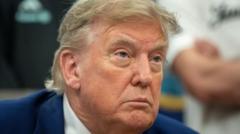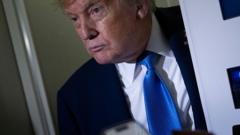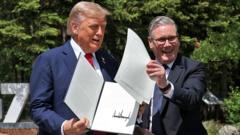**China's robust economy, innovation investments, and control over rare earths position it advantageously in the trade conflict with the US, proving the complexities of global economic dependencies.**
**China's Strategic Advantages in the Ongoing Trade War with the US**

**China's Strategic Advantages in the Ongoing Trade War with the US**
**An overview of Beijing's assets against Republican trade policies amid rising tensions.**
With a trade war unfolding between the United States and China, both nations are experiencing significant economic repercussions. Chinese exports now face tariffs as high as 245%, while Beijing retaliates with its own levies reaching 125% on American goods. As the potential for a global recession looms large, the consumer market, businesses, and financial markets are filled with uncertainty, with President Xi Jinping's administration indicating it is ready for prolonged conflict if necessary. Understanding how China plans to leverage its economic strengths can shed light on the complexities of this trade standoff.
One major advantage China possesses is its ability to absorb the effects of these tariffs more effectively than smaller nations. As the world's second-largest economy and bolstered by a population exceeding one billion, China's internal market can alleviate some pressure from exporters, even as they struggle under the weight of increased tariffs. While there have been attempts to stimulate consumer spending through various incentives, the Chinese government remains focused on consumption-based economic growth. Trade experts indicate that the Chinese Communist Party may be willing to bear short-term discontent to resist what it perceives as aggressive US policies.
China’s intense focus on emerging technologies indicates another layer of strategic preparation. Under Xi's leadership, the nation has made substantial investments across sectors such as electric vehicles and artificial intelligence, challenging American tech companies to keep pace. With plans to invest over $1 trillion in innovation over the next decade, Beijing aims to reduce its reliance on foreign technologies progressively, thereby positioning itself prominently in the global market. Despite US companies seeking to relocate supply chains, they face difficulties replicating China's vast and interconnected infrastructure.
Diplomatically, China's response to the US trade issues has included strengthening economic ties with other nations, particularly within the Global South. Initiatives like the Belt and Road plan are designed to diversify China's trade partnerships, reducing its dependence on the US. Whereas farmers in America once provided a significant percentage of China's agricultural imports, this dependency has markedly decreased, with China now focusing on bolstering homegrown production and sourcing from countries like Brazil.
Lastly, China's influence extends to its control over rare earth minerals essential for advanced technology. With substantial global production capability, China has begun to use this leverage strategically in its trade war countermeasures, as seen with recent restrictions on exports of key minerals. Although this control offers a tactical advantage, experts warn that it may also unearth vulnerabilities, as disruptions in supply could have substantial consequences for US industries reliant on these materials, including defense sectors.
Navigating this complex terrain, it's clear that the ongoing trade war poses significant challenges for both nations, underscoring the deep interdependencies within the global economic landscape and illustrating that neither side holds all the cards.
One major advantage China possesses is its ability to absorb the effects of these tariffs more effectively than smaller nations. As the world's second-largest economy and bolstered by a population exceeding one billion, China's internal market can alleviate some pressure from exporters, even as they struggle under the weight of increased tariffs. While there have been attempts to stimulate consumer spending through various incentives, the Chinese government remains focused on consumption-based economic growth. Trade experts indicate that the Chinese Communist Party may be willing to bear short-term discontent to resist what it perceives as aggressive US policies.
China’s intense focus on emerging technologies indicates another layer of strategic preparation. Under Xi's leadership, the nation has made substantial investments across sectors such as electric vehicles and artificial intelligence, challenging American tech companies to keep pace. With plans to invest over $1 trillion in innovation over the next decade, Beijing aims to reduce its reliance on foreign technologies progressively, thereby positioning itself prominently in the global market. Despite US companies seeking to relocate supply chains, they face difficulties replicating China's vast and interconnected infrastructure.
Diplomatically, China's response to the US trade issues has included strengthening economic ties with other nations, particularly within the Global South. Initiatives like the Belt and Road plan are designed to diversify China's trade partnerships, reducing its dependence on the US. Whereas farmers in America once provided a significant percentage of China's agricultural imports, this dependency has markedly decreased, with China now focusing on bolstering homegrown production and sourcing from countries like Brazil.
Lastly, China's influence extends to its control over rare earth minerals essential for advanced technology. With substantial global production capability, China has begun to use this leverage strategically in its trade war countermeasures, as seen with recent restrictions on exports of key minerals. Although this control offers a tactical advantage, experts warn that it may also unearth vulnerabilities, as disruptions in supply could have substantial consequences for US industries reliant on these materials, including defense sectors.
Navigating this complex terrain, it's clear that the ongoing trade war poses significant challenges for both nations, underscoring the deep interdependencies within the global economic landscape and illustrating that neither side holds all the cards.





















